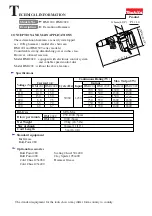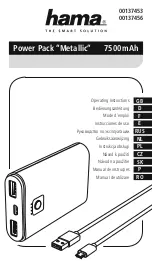
POWX1331LI
EN
Copyright © 2017 VARO
P a g e
|
6
www.varo.com
▪
If contact accidentally occurs, flush with water. If liquid contacts eyes, additionally seek
medical help. Liquid ejected from the battery may cause irritation or burns.
5.6
Service
▪
Your power tool should be serviced by a qualified specialist using only standard spare
parts. This will ensure that it meets the required safety standards.
6 MACHINE-SPECIFIC SAFETY WARNINGS
▪
Use the machine only for dry sanding. Penetration of water into the machine increases the
risk of an electric shock.
▪
Keep hands away from the sawing range. Do not reach under the workpiece. Contact with
the saw blade can lead to injuries.
▪
Use suitable detectors to determine if utility lines are hidden in the work area or call the
local utility company for assistance. Contact with electric lines can lead to fire and electric
shock. Damaging a gas line can lead to explosion. Penetrating a water line causes
property damage or may cause an electric shock.
▪
When working with the machine, always hold it firmly with both hands and provide for a
secure stance. The power tool is guided more secure with both hands.
▪
Secure the workpiece. A workpiece clamped with clamping devices or in a vice is held
more secure than by hand.
▪
Do not use the machine when the quick release lever is not tightened.
▪
Keep your workplace clean. Blends of materials are particularly dangerous. Dust from light
alloys can burn or explode.
▪
Wear protective gloves when changing application tools/accessories.
▪
Application tools/ accessories become hot after prolonged usage.
▪
Do not scrape wetted materials (e. g. wallpaper) or on moist surfaces. Penetration of water
into the machine increases the risk of an electric shock.
▪
Do not treat the surface to be worked with solvent-containing fluids. Materials being
warmed up by the scraping can cause toxic vapours to develop.
▪
Exercise extreme caution when handling the scraper. The accessory is very sharp; danger
of injury.
7 ADDITIONAL SAFETY INSTRUCTIONS FOR BATTERIES AND
CHARGERS
7.1
Batteries
▪
Never attempt to open for any reason.
▪
Do not store in locations where the temperature may exceed 40 °C.
▪
Charge only at ambient temperatures between 4 °C and 40 °C.
▪
Charge only using the charger provided with the tool.
▪
When disposing of batteries, follow the instructions given in the section “Protecting the
environment”.
▪
Do not cause short circuits. If connection is made between the positive (+) and negative (-)
terminal directly or via accidental contact with metallic objects, the battery is short circuited
and an intense current will flow causing heat generation which may lead to casing rupture
or fire.
▪
Do not heat. If batteries are heated to above 100 °C, sealing and insulating separators
and other polymer components may be damaged resulting in electrolyte leakage and/or
internal short circuiting leading to heat generation causing rupture or file. Moreover do not
dispose of the batteries in fire, explosion and/or intense burning may result.
▪
Under extreme conditions, battery leakage may occur. When you notice liquid on the
battery, proceed as follows:































